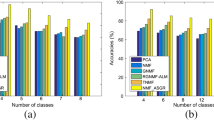Abstract
Nonnegative matrix factorization methods have been widely used in many applications in recent years. However, the clustering performances of such methods may deteriorate dramatically in the presence of non-Gaussian noise or outliers. To overcome this problem, in this paper, we propose correntropy-based dual graph regularized NMF with LP smoothness (CDNMFS) for data representation. Specifically, we employ correntropy instead of the Euclidean norm to measure the incurred reconstruction error. Furthermore, we explore the geometric structures of both the input data and the feature space and impose an Lp norm constraint to obtain an accurate solution. In addition, we introduce an efficient optimization scheme for the proposed model and present its convergence analysis. Experimental results on several image datasets demonstrate the superiority of the proposed CDNMFS method.










Similar content being viewed by others
References
Lei X, Tie J, Fujita H (2020) Relational completion based non-negative matrix factorization for predicting metabolite-disease associations. Knowledge-Based Syst 204:106238.
Li H, Zhang SJ, Liu G (2017) Graph-based discriminative nonnegative matrix factorization with label information. Neurocomputing 266:91–100
Jiang B, Ding C, Luo B (2018) Robust data representation using locally linear embedding guided PCA. Neurocomputing 275:523–532
Deng T, Ye D, Ma R et al (2020) Low-rank local tangent space embedding for subspace clustering. Inf Sci 508:1–21
Xue Y, Tang Y, Xu X et al (2021) Multi-objective feature selection with missing data in classification. IEEE Trans Emerg Topic Comput Intell 10:1–10
Li X, Cui G, Dong Y (2017) Graph regularized non-negative low-rank matrix factorization for image clustering. IEEE Trans Cybernetics 47(11):3840–3853
Yang X, Jiang X, Tian C, et al (2020) Inverse projection group sparse representation for tumor classification: a low rank variation dictionary approach. Knowl Based Syst 196:105768.
Cai D, He X, Han J, Huang TS (2011) Graph regularized nonnegative matrix factorization for data representation. IEEE Trans Pattern Anal Mach Intell 33(8):1548–1560
Zhang Z, Zhang Y, Liu G et al (2019) Joint label prediction based semi-supervised adaptive concept factorization for robust data representation. IEEE Trans Knowl Data Eng 32(5):952–970
Zhang Z, Zhang Y, Li S et al (2021) Flexible Auto-weighted Local-coordinate concept factorization: a robust framework for unsupervised clustering. IEEE Trans Knowl Data Eng 33(4):1523–1539
Lee DD, Seung HS (1999) Learning the parts of objects by nonnegative matrix factorization. Nature 401:788–791
Palmer SE (1977) Hierarchical structure in perceptual representation. Cogn Psychol 6:441–474
Wachsmuth E, Oram M W, Perrett DI (1994) Recognition of objects and their component parts: responses of single units in the temporal cortex of the macaque 4:509–522
Logothetis N, Sheinberg D (1996) Visual object recognition. Annu Rev Neurosci 19:577–621
Leng C, Zhang H, Cai G (2018) A novel data clustering method based on smooth non-negative matrix factorization, in ICSM, pp 24–26.
Chen P, He Y, Lu H, et al (2015) Constrained non-negative matrix factorization with graph Laplacian, International Conference on Neural Information Processing.
Guan N, Tao D, Luo Z, Yuan B (2011) Manifold regularized discriminative nonnegative matrix factorization with fast gradient descent. IEEE Trans Image Process 20:2030–2048
Shang F, Jiao LC, Wang F (2012) Graph dual regularization non-negative matrix factorization for co-clustering. Pattern Recogn 45(6):2237–2250
He R, Zheng W, Hu B (2011) Maximum correntropy criterion for robust face recognition. IEEE Trans Pattern Anal Mach Intell 33(8):1561–1576
Zhou N, Dong B, et al (2019) Maximum correntropy criterion-based robust semi-supervised concept factorization for image representation. IEEE Trans Neural Networks Learn Syst.
Wang Y, Wu S, Mao B et al (2014) Correntropy induced metric based graph regularized non-negative matrix factorization. Neurocomputing 204(5):172–182
Lee DD, Seung H (2011) Algorithms for non-negative matrix factorization. Adv Neural Inform Process Syst 13.
Shu Z, Fan H et al (2017) Multiple Laplacian graph regularized low-rank representation with application to image representation. IET Image Proc 6:370–378
Chen B, Wang X, Li Y et al (2019) Maximum correntropy criterion with variable center. IEEE Signal Process Lett 99:1–1
Shu Z, Wu X, You C et al (2020) Rank-constrained nonnegative matrix factorization algorithm for data representation. Inf Sci 528:133–146
He Y, Fei W, Li Y et al (2019) Robust matrix completion via maximum correntropy criterion and Half Quadratic optimization. IEEE Trans Signal Process 68:181–195
Shu Z, Wu X et al (2019) The optimal graph regularized sparse coding with application to image representation. PRCV 2:91–101
Yang J, Cao J, Xue A (2020) Robust Maximum mixture correntropy criterion-based semi-supervised ELM with variable center. IEEE Trans Circuit Syst 99:3572–3576
He R, Zhen W, Hu B (2011) Maximum correntropy criterion for robust face recognition. IEEE Trans Pattern Anal Mach Intell 33(8):1561–1576
Trigeorgis G, Bousmalis K, Zafeiriou S et al (2017) A deep matrix factorization method for learning attribute representations[J]. IEEE Trans Pattern Anal Mach Intell 39(3):417–429
Acknowledgements
This work was supported by the National Natural Science Foundation of China [Grant No. 61603159, 62006097, 62162033], Natural Science Foundation of Jiangsu Province [Grant No. BK20160293, BK20200593], Excellent Key Teachers of QingLan Project in Jiangsu Province.
Author information
Authors and Affiliations
Corresponding author
Additional information
Publisher's note
Springer Nature remains neutral with regard to jurisdictional claims in published maps and institutional affiliations.
Rights and permissions
About this article
Cite this article
Shu, Z., Weng, Z., Yu, Z. et al. Correntropy-based dual graph regularized nonnegative matrix factorization with Lp smoothness for data representation. Appl Intell 52, 7653–7669 (2022). https://doi.org/10.1007/s10489-021-02826-0
Accepted:
Published:
Issue Date:
DOI: https://doi.org/10.1007/s10489-021-02826-0




